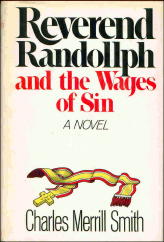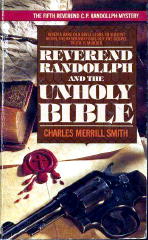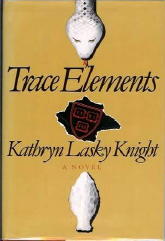December 2008
Monthly Archive
Sat 27 Dec 2008
Posted by Steve under
Reviews[6] Comments
MARGERY ALLINGHAM – Dancers in Mourning.
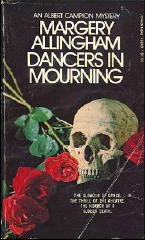
Manor, paperback reprint, 1976. First edition: William Heinemann, UK, 1937. US first: Doubleday Crime Club, 1937. Also published as: Who Killed Chloe? Avon Murder Mystery Monthly #17, 1943. Many other paperback reprints including: Jonathan Press Mystery J32; Macfadden, 1967; Bantam, 1990; Carroll & Graf, 1996; Felony & Mayhem, trade ppbk, 2008.
One wonders how many other novels first published in 1937 are still in print. I’m not wondering hard enough to actually sit down at the computer and do some investigating, mind you, but in any case, and this is the point, Dancers in Mourning is one of them. (I also have a feeling that of the set of novels first published in 1937 but still in print, a sizable percentage of them would be mysteries.)
I’ve read two of Allingham’s mysteries that I remember: one with Mr. Albert Campion and one without, and the one with Mr. Campion I remember more than the other. But I don’t remember Mr. Campion himself very well, and I think that Allingham rather wanted it that way.
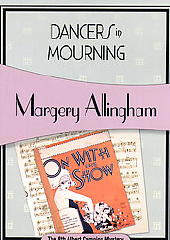
I remember large spectacles and a sometimes vacuous look on his face from that book (title not remembered off-hand) and now this one. Other than that many of the other characters in this book consider him “young,” I’d be hard-pressed to describe him further.
There is a convergence of two worlds in Dancers in Mourning. First, the world of the theatre, or musical comedy, to be specific, the world of superstar dancer Jimmy Sutane and his sell-out production of The Buffer, based on the fictional memoirs of Campion’s friend, Mr. William Faraday (who also appeared in Police at the Funeral).
And secondly, and more importantly, the setting changes to that of Sutane’s country home, where people in show business and with show business connections drop in and out, but the core of people around Sutane are all either good friends or family.
But, and here is where Campion is drawn in, who is playing all of the small but nasty practical jokes on Sutane? And, as it happens, who killed Chloe, the aging songstress who invited her way down for the weekend? Or was it suicide, or a natural death before falling from a small bridge in front of Sutane’s automobile?

Campion’s progress on the case is hampered by the discovery that is falling in love with Sutane’s wife, or that he could very easily, given any sign of reciprocation, even to extent of making several serious mistakes along the way.
Some of the characters flit and out without being recognized as more than shadows of people, others I suspect I will remember for a long time. In terms of general atmosphere, I was reminded of John Dickson Carr more often than not, although the romance elements in Carr’s work were never as crucial (or real) as they are in this one.
On the other hand, there is no locked room mystery involved in Dancers in Mourning. Only a murderer with no compunction about killing, including a home-made bomb at a railway station. Once again it is Campion’s preoccupation with other matters that make the ending work as well as it does.
Of course the solution is obvious, and it should have been all along. And so help me, it wasn’t – all the way up the final two or three pages
Sat 27 Dec 2008
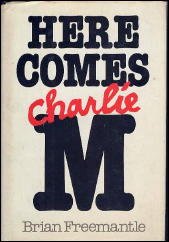 BRIAN FREEMANTLE – Here Comes Charlie M. Doubleday, US, hardcover, 1978; ppbk reprint: Ballantine, 1980. Published in the U.K. as Clap Hands, Here Comes Charlie; Jonathan Cape, 1978; ppbk reprint: Arrow, 1987.
BRIAN FREEMANTLE – Here Comes Charlie M. Doubleday, US, hardcover, 1978; ppbk reprint: Ballantine, 1980. Published in the U.K. as Clap Hands, Here Comes Charlie; Jonathan Cape, 1978; ppbk reprint: Arrow, 1987.
Spies can easily outlive their usefulness. The new brooms of equally new administrations have moved in on both sides of the Atlantic, and Charlie Muffin, who proved to be so embarrassing a non-willing pawn in the preceding book in this series (a book called Charlie Muffin, or simply Charlie M. in the US) is the dirt that has to be swept out. Guilt-ridden and on the defensive as he is, however, it is his nature to fight back.
And the nature of sequels being what it is, the keen edge of cutting commentary concerning the spy business is lost, or at least it takes a while for it to be sharpened up again. This time it seems almost too easy — the top minds of two huge intelligence organizations pose very little challenge to the intrepid Charlie M.
– From The MYSTERY FANcier, Vol. 3, No. 4, July-Aug 1979 (slightly revised).This review also appeared earlier in the Hartford Courant.
[UPDATE] 12-27-08. I had no idea at the time, but Charlie Muffin has turned out to be one of the most durable spy characters in hardcover spy fiction. He’s appeared in 14 books, listed below. Guys like Matt Helm, Joe Gall and Nick Carter have lasted longer in paperback, to be sure, and maybe you can think of others who might rival him in hardcover, but it’s quite a record.
And one that’s passed below my own personal radar. Until coming across this review, I hadn’t thought of Charlie M. in ages, perhaps because so few of his adventures have come out in paperback. Expanded from the Revised Crime Fiction IV, by Allen J. Hubin, here’s the list:
MUFFIN, CHARLIE
o Charlie Muffin. Cape 1977. [US:
Charlie M.]
o Clap Hands, Here Comes Charlie. Cape 1978. [US: Here Comes Charlie M.]
o The Inscrutable Charlie Muffin. Cape 1979. [US: same]
o Charlie Muffin’s Uncle Sam. Cape 1980. [US: Charlie Muffin, U.S.A.]
o Madrigal for Charlie Muffin. Hutchinson 1981. [No US edition]
o Charlie Muffin and Russian Rose. Century 1985. [US? The Blind Run]
o Charlie Muffin San. Century 1987. [US: See Charlie Run]
o The Bearpit. Century 1988. [No US edition]
o The Runaround. Century 1988. [US: same]
o Comrade Charlie. Century 1989. [US: same]
o Charlie’s Apprentice. Century 1993. [US: same]
o Charlie’s Chance. Orion 1996. [US: Bomb Grade]
o Dead Men Living. Severn 2000. [US: same]
o Kings of Many Castles. Severn 2001. [US: same]
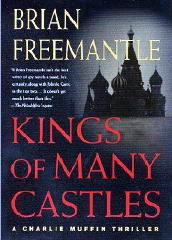
As for author Brian Freemantle, he doesn’t seem to have stopped writing, unless it’s been very recently. He’s been averaging a book or two a year over the past 30 years, either under his own name or as by one of his four pseudonyms: Harry Asher, Jonathan Evans, John Maxwell or Jack Winchester. For a long list of all the books he’s written, along with a large assortment of covers, see the UK Fantastic Fiction website.
Sat 27 Dec 2008
THEY WERE SO YOUNG. US title of Mannequins für Rio. 1954-1955, Corona Filmproduktion [Germany]/ Lippert Productions [US]. Johanna Matz, Scott Brady, Ingrid Stenn, Raymond Burr, Gisela Fackeldey. Director: Kurt Neumann.
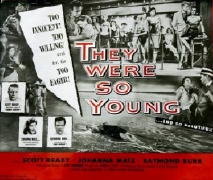
One wonders, when one often does it situations such as this, why on earth Scott Brady and Raymond Burr found themselves in a German movie about (of all things) white slavery in Brazil. There is only one answer. The second and third do not count.
The production code in the US would not even allow the movie to be shown over here, or so I’ve been told, until some scenes were added at the beginning and end to change the emphasis from prostitution to everyday ordinary racketeering. (The scenes are not included in its recent repackaging for DVD, thank goodness.)
I’m referring to a box set called Forgotten Noir, Series 1, and I can tell you frankly that if one of the leading players weren’t in it, Raymond Burr, an absolute icon of film noir in his pre-Perry Mason days, this movie would still be forgotten, Scott Brady’s presence 100% notwithstanding. Brady made some good movies, but a heavyweight in the genre of film noir, he’s not.
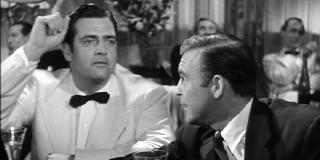
The idea is that young European women are enticed by ads in newspapers and magazines into becoming models for an agency that trains them, treats them well, then ships them off to Brazil while keeping their passports and other papers, then forcing them (in a high-class way) to becoming good friends with the male “buyers” who come to their staged and strictly phony fashion shows.
One girl who rebels, Eve Ullmann (Johanna Matz), finds a friend and ally in American engineer Richard Lanning (Brady), whose boss Jaime Coltos (Burr) he does not realize is really behind the racket. Don’t worry. You’ll realize the same thing as soon as you see him (Raymond Burr, that is). Brady is a little slow on the uptake, but that’s OK. His intentions are good.
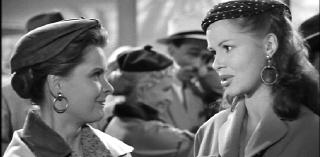
So a noir film? No, not really, but if you wanted to stretch the point, I suppose you could make a decent case for it. All it really is is a low budget black-and-white crime thriller that’s moderately entertaining in its better moments, and having a plot twist or two in between. It falls to less than mediocre at other times, though, so it’s your dime, and you can call it.
PostScript. I see that I didn’t say much about Johanna Matz, who plays the innocent Eve Ullmann with a double-barreled combination of virtue and courage that the role required. I don’t think it was an easy task. (She’s the girl on the left in the photo just above.)
In all honesty, the more I think about it, if she hadn’t been up to it, I don’t believe that the story would have been palatable at all. (According to IMDB she appeared in about 50 German movie and TV productions; this may be the only one she was in that was ever released in the US.)
Fri 26 Dec 2008
I’ve been too busy to do more than to finish up the C-authors today. You can also find these entries online in the A-C section of the online Addenda to the Revised Crime Fiction IV, by Allen J. Hubin.
CREEKMORE, DONNA (R.) 1926?-1995? Pseudonym: Diana Campbell. Under her own name, the author of two romantic suspense novels included in the Revised Crime Fiction IV (and under her pen name, the author of one more).
The Coachman’s Daughter. Dell, pb, 1979, pb; Linford, UK, 1992. “Her sister’s mysterious disappearance and rumors of the gruesome ‘Shoreditch Slasher’ filled violet-eyed Linnet Hamilton with terror…”
The Silver Shroud. Manor, pb, 1978. Add UK edition: Linford, pb, 1992.
CROSS, NEIL.
Mr. In-Between. Film: Verve, 2001 (scw: Peter Waddington; dir: Paul Sarossy); also released as The Killing Kind.
CUNNINGHAM, E. V. Pseudonym of Howard Fast.
Sally. TV movie: CBS, 1971, as The Face of Fear (scw: Edward Hume; dir: George McCowan)
Shirley. TV movie: ABC, 1971, as What’s a Nice Girl Like You…? (scw: Howard Fast; dir: Jerry Paris)
CURTISS, URSULA.
Out of the Dark. TV movie: CBS, 1988, as I Saw What You Did … and I Know Who You Are! (scw: Cynthia Cidre; dir: Fred Walton)
CUSSLER, CLIVE.
Sahara. Film: Paramount, 2005 (scw: Thomas Dean Donnelly, Joshua Oppenheimer, John C. Richards, James V. Hart; dir: BreckEisner) SC: Dirk Pitt (Matthew McConaughey)
Thu 25 Dec 2008
I’ll soon be finished with the A-C section of the online Addenda to the Revised Crime Fiction IV, by Allen J. Hubin. Through Parts I through III, that is.
CORBY, JANE (IRENITA). 1899- ? Pseudonyms: Laura Brighton, Jean Carew & Joanne Holden. Of some 24 novels published under her own name, many of them nurse romances, nine are included the Revised Crime Fiction IV. Of these, most are apparently gothic romances. (Those written under her various pen names fall in very much the same categories.)
Peril at Stone Hall. Arcadia, hc, 1969. Also published as: Fall, Darkness, Fall! Leisure, pb, 1975, as by Laura Brighton. Add UK edition: Linford, pb, 1993. “Mystery lured her to the old castle. Death would show her the way out.” Shown is the US Macfadden paperback edition.
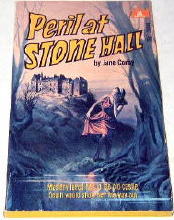
CORNWELL, BERNARD. 1944- . Clarification: This was his name at birth; as an infant he became Bernard Wiggins when adopted by the Wiggins family, but legally changed his name back to Bernard Cornwell when Joseph Wiggins died. Prolific British author of historical fiction; he has also written five contemporary thriller novels, many of them involving sailing, which are included in the Revised Crime Fiction IV. Shown is the cover of the US edition of one of these; the UK title is Sea Lord (Michael Joseph, 1989).
COUGHLIN, WILLIAM J(EREMIAH).
Shadow of a Doubt. TV movie: Scripps-Howard, 1995 (scw & dir: Brian Dennehy). SC: Charlie Sloan (Brian Dennehy).
COURTENAY, BRYCE
-Jessica. Australia: Viking, hc, 1998. Joseph, UK, hc, 1999. Setting: Australia; ca.1914. (Add time frame to the setting.) TV movie: Umbrella, 2004 (scw: Peter Yeldham; dir: Peter Andrikidis)
COXE, KATHLEEN BUDDINGTON. Joint pseudonym of Amelia Reynolds Long & Edna McHugh. Under this pen name, the author of one mystery novel included in the Revised Crime Fiction IV. See below:
Murder Most Foul. Phoenix, 1946, hc. Setting: Pennsylvania; Academia. (Add precise location.) Leading characters: Buddie Cox, female undergraduate student, and Francis Thrush, psychology professor.
CRAIG, JOHN (ERNEST).
If You Want to See Your Wife Again. TV movie: Brentwood, 1972, as Your Money or Your Wife (scw: J. P. Miller; dir: Allen Reisner)
CRANE, CAROLINE.
Summer Girl. TV movie: Bruce Lansbury, 1983 (scw: A. J. Carothers; dir: Robert Michael Lewis)
Thu 25 Dec 2008
Posted by Steve under
ReviewsNo Comments
A REVIEW BY MARY REED:
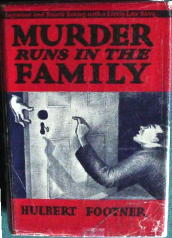
HULBERT FOOTNER – Murder Runs in the Family.
Harper & Brothers, US, hardcover, 1934 (shown without jacket). Hardcover reprint: A. L. Burt (shown with jacket). UK hardcover: Collins Crime Club, 1934.
The novel opens with a classic situation. Lounsbery, CT, millionaire mill owner and all round rotter James Beardmore is blackmailing his lovely secretary Freda Rollin to force her to agree to marry him when his divorce becomes final.
Lance McCrea, who lives at the same boarding house as Freda, has fallen for her and is comforting her after he hears her crying when her “fiance” arrives on the scene. Fisticuffs ensue wherein McCrea soundly thrashes the odious Beardmore.
McCrea decides to force Beardmore to tell him what threat he is holding over Freda’s head and then deal with it in some way in order to save her, so he buys a gun for protection and sets out to have a little chat with Beardmore.
Unfortunately for McCrea, he winds up locked in Beardsmore’s library with his body, having followed the captain of industry to his large estate outside town. The house had been shut up after Mrs Beardsmore went to Reno to establish residence and get her divorce, so what was Beardsmore doing there at night with a luncheon basket containing two servings of salad, lobster mayonnaise, sandwiches, champagne, and coffee?
Could any one of a number of husbands and fathers in town with reason to hate the mill owner be responsible? Is there a connection between his death and that of his equally rotten father, shot and killed by a disgruntled mill employee twenty or so years before? Could one of the other Beardsmores be responsible? After all, they seem quite happy in upholding the family tradition of, well, rottennness.
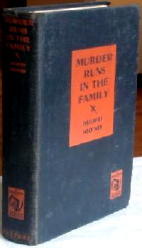
McCrea does not have time to ponder these questions as no sooner has he escaped from the locked library when a posse of police arrive and after an exciting chase through the house and across the estate he is suddenly assaulted by a man lurking in the dark countryside, only to be saved from being shot with his own gun by the arrival of a pursuing policemen, who gets into a fight with the would-be assassin.
While this is under way McCrea seizes his chance to run off into the woods, but then hears the sound of a shot….
My verdict: Although the novel starts off as a mystery, it quickly develops into a well written thriller that reminded me more than once of John Buchan’s The 39 Steps inasmuch as most of the narrative is devoted to the protagonist while he’s on the run from the police and other enemies.
McCrea proves to be a quick thinking and resourceful young man and ultimately justice is done. It’s an enjoyable read and I think would make a fine period film.
Etext: http://gutenberg.net.au/ebooks08/0801401.txt
Wed 24 Dec 2008
CHINA GIRL. 20th Century Fox, 1942. Gene Tierney, George Montgomery, Lynn Bari, Victor McLaglen, Sig Ruman, Robert Blake, Philip Ahn. Screenwriter: Ben Hecht; director: Howard Hathaway.
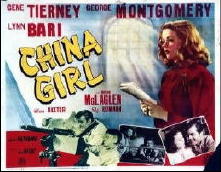
Many reviewers do not appear to know what to make of this film, and without a sense of perspective — and history — I’d have to agree that it doesn’t fit into any kind of standard category I can think of either, not satisfactorily, at least.
Eighty percent of the film would have constituted a well above average B-movie adventure thriller, but the scenes at the beginning, with the Japanese army shooting Chinese peasants lined up along (and falling into) a long earthen burial pit belie any sense of light amusement value right from the start.
Nor is the ending, with Japanese warplanes wiping out an entire Chinese village, filled with screaming people, many of them children, intended to have anyone whistling their way out of theater. No, what this is is a bitterly honest anti-Japanese wartime propaganda film disguised as an everyday spy story and romance, with a budget and production values a notch higher than would have been given to it if that was all it was intended to be.
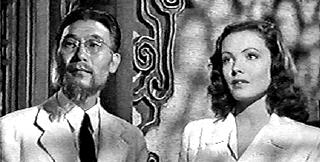
George Montgomery plays an ace newsreel cameraman, Johnny ‘Bugsy’ Williams, who’s assisted in escaping from a Japanese detention center by Lynn Bari and Victor McLaglen, who have their own irons in the fire. Gene Tierney is Haoli Young, the half-Chinese girl whose life is interrupted by Williams, not smoothly at first, but her self-applied veneer of protection is first cracked, then weakened, and finally disappears.
Comic relief is provided by Robert Blake as a young Mandalay street urchin who attaches himself to Williams. Haoli�s father is played by Philip Ahn, a teacher whose classroom demeanor was exactly the same in 1942 as it was 30 years later as the mentor to David Carradine as Kwai Chang Caine in the TV series Kung Fu.
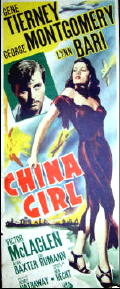
George Montgomery plays earnest very well, once his sharp edges have been worn away, while Gene Tierney is both beautiful and exotic as well as totally natural. No surprise there. Lynn Bari seems to have caught the eyes of some reviewers, but for me, not this time around.
As for the movie as a whole, it is as I’ve suggested, a mishmash of this and that, a movie made by design and good intentions, but when the design is no longer needed, then neither are the intentions.
And you can take the following to the bank, too. When any movie takes place in western Asia in November 1941, and one of the characters comes across a secret codebook containing the number 7 and the deciphered word “pearl,” you will know that you now know more than any of the characters know, except for the bad guys, and you will know exactly who they are.
Not that you exactly need a scorecard.
Wed 24 Dec 2008
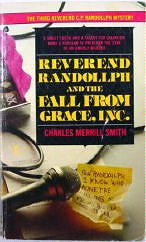 CHARLES MERRILL SMITH – Reverend Randollph and the Fall from Grace, Inc.
CHARLES MERRILL SMITH – Reverend Randollph and the Fall from Grace, Inc.
G. P. Putnam’s Sons, hardcover, 1978. Paperback reprint: Avon, 1982.
This third mystery adventure of C. P. Randollph, a one-time pro quarterback now turned minister, continues to learn the ins and outs of his new profession, and in this case more specifically, how he finds that a clergyman’s responsibilities entail more than just his presence at Sunday morning services.
In addition, there are often affairs of a political nature to contend with, both within the church and out. In this case, as an extreme example, being murdered are the close associates of a television evangelist who hopes to join Randollph’s denomination before announcing his bid for the U. S. Senate.
Without a doubt, organized religion can always use such engagingly down-to-earth men of the cloth as Reverend Randollph. Reporting fairly on the mystery, however, I reluctantly have to admit that the motive for murder is an unlikely one.
– From The MYSTERY FANcier, Vol. 3, No. 4, July-Aug 1979 (slightly revised).This review also appeared earlier in the Hartford Courant.
[UPDATE] 12-24-08. The Reverend Randollph books, concerned with everyday church life as they were, remain among my favorite mysteries in which clergymen do double-up duty as sleuths and detectives.
Charles Merrill Smith wrote five of them before a relatively early death, with a sixth almost finished at the time of his passing. The book was completed by his son Terrance Lore Smith, also a mystery novelist. Phil Grosset, on his webpage for the character, says that Terrance intended to continue the Reverend Randollph stories on his own, but two years later he was killed himself in an automobile accident.
From the Revised Crime Fiction IV, by Allen J. Hubin, here’s a list of all six Reverend Randollph mysteries:
SMITH, CHARLES MERRILL. 1918-1985.
Reverend Randollph and the Wages of Sin. Putnam, 1974.
Reverend Randollph and the Avenging Angel. Putnam 1977.
Reverend Randollph and the Fall from Grace, Inc. Putnam, 1978.
Reverend Randollph and the Holy Terror. Putnam, 1980.
Reverend Randollph and the Unholy Bible. Putnam, 1983.
Reverend Randollph and the Splendid Samaritan (completed by the author’s son, Terrance Lore Smith). Putnam, 1986.
Tue 23 Dec 2008
IT’S ABOUT CRIME
by Marvin Lachman
C. W. SCOTT-GILES – The Wimsey Family: A Fragmentary History Compiled from Correspondence with Dorothy Sayers.
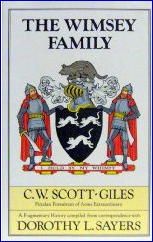
Victor Gollancz Ltd, UK, hardcover, 1977; New English Library, pb, 1979. Harper & Row, US, hc, 1978; Avon, pb, October 1979.
As a fan of Dorothy L. Sayers I would desperately like to recommend The Wimsey Family, by C. W. Scott-Giles. I have long been on record as saying there should be more of the Baker Street Irregular type of speculative writing about other detectives than Sherlock Holmes.
Based on correspondence with Sayers, Scott-Giles has provided a genealogical history of Lord Peter Wimsey. However, most of it concerns pre-1700 history and does not directly Concern the characters Sayers created. It may be of interest to students of arms and heraldry, but it is not especially vital to mystery fans. It certainly provides no answers to such vital questions as: what really occurred between Lord Peter and the German soprano in Vienna?
This is also an over-priced book. Refuting the conventional laws of supply and demand, the [US hardcover] publisher has apparently assumed that since there will be a small audience, a high price is needed to maximize profit (or minimize loss). Six dollars and ninety-five cents is a bit much, even in these inflated times, for an 88 page book with a handful of drawings and not even a family tree diagram, something essential to an enterprise of this sort.
Mr. Scott-Giles, due to his obvious love of the Wimsey canon, would appear to have been well-qualified to do the definitive “biography” of Lord Peter. It is unfortunate that he did not give himself a wider canvas.
– From The MYSTERY FANcier, Vol. 3, No. 4, July-Aug 1979 (very slightly revised).
[UPDATE] 12-24-08. Geoff Bradley just emailed me (this is Steve) to point out that the Dorothy L. Sayers Society has recently published a new edition of this book. The price, including postage to the US, $38. (Don’t anyone tell Marv.)
For more details, email me or Geoff (at Geoffcads @ aol.com), or even better if you’re a subscriber to CADS, the mystery zine that Geoff publishes, see page 14 of #55, the most recent issue.
Highlights of #55 include a long article by Agatha Christie written in 1945 in which she discusses the work of her contemporary mystery writers; Josef Hoffmann on Mildred Davis; Jon L. Breen on Charlie Chan; and more. I’ve only begun to scratch the surface.
To obtain a copy and/or to start a subscription, contact Geoff (address above). Highly recommended!
Tue 23 Dec 2008
KATHRYN LASKY KNIGHT – Mortal Words.
Pocket, reprint paperback; 1st printing, July 1991. Hardcover edition: Summit Books, 1990.
It’s a comfort then [after reading and reviewing Ben Sloane’s Hot Zone] to return to the real world, where deaths still occur, but when they do, they’re seriously mourned. The real world, unfortunately, is filled with violence, there’s no denying that, but it’s nice to be able to feel that you’re not the only one who feels that violence is the problem, and very seldom is it the solution.
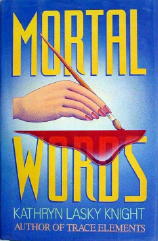
On the top of the front cover, even before the title, is the heading: “Calista Jacobs is back!” Unfortunately, this is the first I knew about Trace Elements, which was Callista’s first mystery-adventure, along with her precocious son Charley, who is now 13, so I never knew she was away.
Luckily (in a matter of speaking) enough references to the earlier book are made that I may not even have to go out looking for it. In terms of updating her life, in Mortal Words Calista is now a widow. She is also a world-famous illustrator of children’s books, and she and Charley live in that hotbed of liberalism, Cambridge, Mass.
This is definitely not a book for readers of a more conservative persuasion. The book opens with Calista and her friends being harassed by a fervent right-wing fundamentalist at a librarian’s literary conference, and the plot grows to include born-again evangelists, evolutionary racists, and Nazi-inspired sperm banks. Moral cripples all, according to Ms. Knight, but nonetheless they embody a powerful anti-science movement, and quite the nasty combination indeed.
Naturally Calista is opposed to all this with every fiber of her being, and equally naturally it makes her an obvious target. Murder also occurs, but with Charley’s computer-hacking abilities and general intellectual curiosity, along with Calista’s growing friendship with Archie Baldwin, noted archaeologist, the villains stand very little chance.
As you may have gathered, here is a mystery that is bursting the seams of plain old (and old-fashioned) detective fiction, and in my opinion, it certainly wouldn’t hurt anybody to read it. As a detective story, though, I think it’s seriously flawed by the total lack of attention the Boston police force pay to the murder and to the invaders of Calista’s home.
They are so severely excluded from the story, as a matter of fact, that you begin to wonder if they could possibly be in on the plot. I hope I’m not saying too much without a [WARNING: Plot Alert] that they are not, but it certainly makes the rest of the story a little harder to swallow.
This same lack of concern on the part of Calista and Archie as to their safety, and that of Charley, is just as hard to accept. If murder and the invasion of one’s home isn’t warning enough that their opponents are serious, what is?
— Reprinted from Mystery*File 33, Sept 1991 (revised).
[UPDATE] 12-23-08. The author wrote only four books in the series. As Kathryn Lasky, she’s been much prolific as a writer of children’s books, both fiction and non-fiction, for which she’s been given a list of awards as long as your arm. Expanded from her entry the Revised Crime Fiction IV, by Allen J. Hubin, here are her four mysteries, all with Calista Jacobs:
KNIGHT, KATHRYN LASKY. 1944- .
Trace Elements. Norton, hc, 1986. Pocket, pb, 1987.
Mortal Words. Summit, 1990. Pocket, pb, 1991.
Mumbo Jumbo. Summit 1991. Pocket, pb, 1992.
Dark Swan. St. Martin’s, 1994. Worldwide, pb, 1996.
« Previous Page — Next Page »


 BRIAN FREEMANTLE – Here Comes Charlie M. Doubleday, US, hardcover, 1978; ppbk reprint: Ballantine, 1980. Published in the U.K. as Clap Hands, Here Comes Charlie; Jonathan Cape, 1978; ppbk reprint: Arrow, 1987.
BRIAN FREEMANTLE – Here Comes Charlie M. Doubleday, US, hardcover, 1978; ppbk reprint: Ballantine, 1980. Published in the U.K. as Clap Hands, Here Comes Charlie; Jonathan Cape, 1978; ppbk reprint: Arrow, 1987.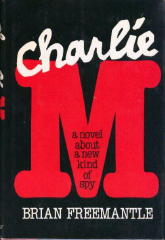
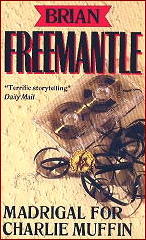
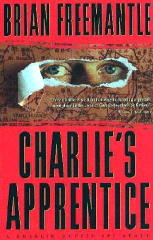




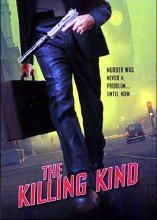
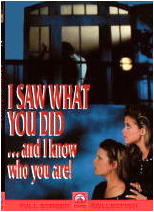
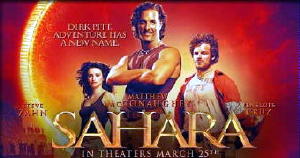


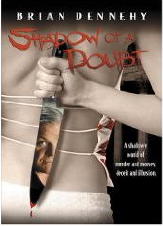
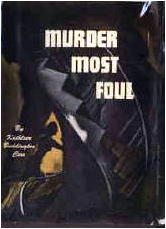





 CHARLES MERRILL SMITH – Reverend Randollph and the Fall from Grace, Inc.
CHARLES MERRILL SMITH – Reverend Randollph and the Fall from Grace, Inc.